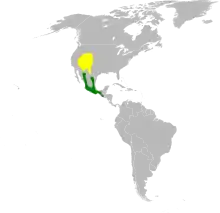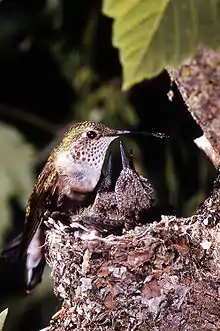Broad-tailed hummingbird
The broad-tailed hummingbird (Selasphorus platycercus) is a medium-sized hummingbird species found in highland regions from western United States and Western Canada to Mexico and Guatemala.[3][4]
| Broad-tailed hummingbird | |
|---|---|
 | |
| Adult male at a feeder | |
| Scientific classification | |
| Domain: | Eukaryota |
| Kingdom: | Animalia |
| Phylum: | Chordata |
| Clade: | Dinosauria |
| Class: | Aves |
| Clade: | Strisores |
| Order: | Apodiformes |
| Family: | Trochilidae |
| Genus: | Selasphorus |
| Species: | S. platycercus |
| Binomial name | |
| Selasphorus platycercus (Swainson, 1827) | |
 | |
| Range of S. platycercus Breeding range Wintering range | |
Description

Medium in size, the broad-tailed hummingbird is 4 inches (10 cm) in length and possesses an overall wingspan of 5.25 inches (13.3 cm). Weighing around 3.6 grams (0.13 oz), the female tends to be slightly larger than the male.[5][6] Adults of both sexes show an iridescent green back, white eye ring and a rounded black tail projecting beyond their wing tips, from which their name was inspired.[5][6]
This species shows sexual dimorphism, which means that male and female have different characteristics. The male possesses a characteristic bright rose-red gorget.[6] An identification characteristic is the white eye ring.[5] The female can be distinguished from the male by her paler coloration, cinnamon flanks, and spotted cheeks absent in the male.[5][7]
Vocalizations
The broad-tailed hummingbird produces several different sound patterns. This bird's call sounds like a sharp “cheet”, which is repeated “cheet cheet cheet cheet...”.[3][7] Hummingbird wing beats have also been found to be a communication signal. These birds produce two different types of sound using their wing beat. The first one is a “wing hum” and is simply produced when the hummingbird flies. This type of wing beat has a sound that ranges from 35 to 100 Hz, and both sexes are able to produce it for communication. The second is “wing trills” produced by the male hummingbird during courtship displays.[8] The wing trill produces a buzzing sound and can be heard 50 m away by other males and 75 m away by other females.[9] This sound is produced when air passes rapidly through the 9th and 10th primary feathers.[8] In one experiment, birds without this wing trill lost their territory more easily to more aggressive birds.[9]
Taxonomy
The broad-tailed hummingbird, Selasphorus platycercus, is a member of the order Apodiformes, in the family Trochilidae. Hummingbird taxonomy has not been extensively studied, but its phylogenic division can be divided as a family into nine clades in which the broad-tailed hummingbird is a member of the "Bee group" and included in the Selasphorus genus. This genus is composed of 6 members taxonomically distinguished based on color characteristics.[10][11][12] This genus is characterized by hummingbirds with a plumage containing rufous coloration and a neck gorget of orange to purple in males.[11]
Members of this genus include:[12][13]
Selasphorus sasin : Allen's hummingbird
Selasphorus rufus : Rufous hummingbird
Selasphorus scintilla : Scintillant hummingbird
Selasphorus ardens : Glow-throated hummingbird
Selasphorus flammula :Volcano hummingbird
On a geographic scale, the genus Selasphorus can be subdivided into 2 groups of species, one living in North America, and a second in the region of Costa Rica and Panama.[11]
Habitat
This hummingbird is seen in the understory or under tree canopies of pine and oak woodland. It forages in open areas with flowers or in grasslands among trees and shrubs.[3][7] Its breeding habitat is mainly in subalpine meadows, foothills, montane valleys, and stands of aspen or spruce.[14][15]
Distribution
The broad-tailed hummingbird is found from Guatemala to Mexico, and western United States and Western Canada during summer,[3][4][16][17] while wintering regions are mainly in southern Mexico and Guatemala.[16]
Migration
This species exhibits partial migration, depending on the northern range during winter.[16] The specific migratory route used by the broad-tailed hummingbird remains unknown, although migrating populations winter in southern Mexico or Guatemala and return to their breeding area in spring.[14][15][16] Males arrive first to the breeding range, followed by breeding females.[6][14][18] Some populations of the broad-tailed hummingbird in southern Mexico and Guatemala do not migrate, a variation in behavior called "sedentary".[16]
Diet
The diet of the broad-tailed hummingbirds consists mainly of insects and nectar of plants that are “hummingbird-flowered”.[19] These types of flower are characterized by high nectar production and red corollas with a tubular shape, such as Aquilegia elegantula.[19]
Reproduction

The range of breeding locations appear to be from central Montana in the north to Guatemala in the south.[4] Although broad-tailed hummingbirds have been seen in British Columbia, these birds appear to be accidental migrants, with no evidence for breeding at such northern latitudes.[4]
Breeding site
The broad-tailed hummingbird has a promiscuous mating system and does not form a pair bond.[15] The reproduction time for broad-tailed hummingbirds correlated with the time flower production is at its peak.[18]
Courtship
Male perform an aerial display to attract females during the breeding season. Males will fly high and dive while producing a trill sound with their wing feathers.[20]
Nest construction
In 70% of cases, females return to their nest site from one year to the next.[14] Females build their nest alone, without the male help. The overall nest construction may take around 4 to 5 days.[6] The nest has an overall cup shape and is stuck to a tree branch with spider webs, camouflaged by the addition of an external layer of lichen, moss, and tree material.[21] Nest material can be stolen by other females for the construction of a nest.[22]
Brooding
The female will lay two white eggs of around 1.2–1.5 centimetres (0.47–0.59 in) in length and incubate them alone for around 16 to 19 days.[20] Nest cup diameter increases as the chicks age.[21] Chicks are altricial at their hatch, and will take around 10 to 12 days for feathering.[6] The female will stay with the fledged young up to several weeks.[15]
Conservation status
This species conservation status is “Least Concern ”, indicating it is not an endangered species, having a wide range and moderate population size,[1] although one survey indicated a 52% decline in population between 1966 and 2015.[20] It appears to be adapted to human-modified habitats.[6][20]
References
- BirdLife International (2016). "Selasphorus platycercus". IUCN Red List of Threatened Species. 2016: e.T22688293A93190741. doi:10.2305/IUCN.UK.2016-3.RLTS.T22688293A93190741.en. Retrieved 11 November 2021.
- "Appendices | CITES". cites.org. Retrieved 2022-01-14.
- Howell, Steve N. G.; Webb, Sophie (1995-03-30). A Guide to the Birds of Mexico and Northern Central America, page 427. OUP Oxford. ISBN 9780198540120.
- DF Fraser (2015). "Broad-tailed Hummingbird, Selasphorus platycercus". British Columbia Breeding Bird Atlas, Bird Studies Canada. Retrieved 15 October 2018.
- Sibley, David Allen (2016). The Sibley Field Guide to Birds of Eastern North America. United States: Alfred A.Knopf. p. 221. ISBN 978-0-307-95791-7.
- "Broad-tailed Hummingbird". Cornell Lab of Ornithology, Ithaca, NY. 2017. Retrieved 15 October 2018.
- Vallely AC, Dyer D (2018). Birds of Central America : Belize, Guatemala, Honduras, El Salvador, Nicaragua, Costa Rica, and Panama. Princeton University Press. ISBN 9780691138015.
- Hunter, Todd A. (2008). "On the role of wing sounds in hummingbird communication". The Auk. 125 (3): 532–541. doi:10.1525/auk.2008.06222. ISSN 0004-8038. S2CID 85428647.
- Miller, Sarah J.; Inouye, David W. (1983). "Roles of the wing whistle in the territorial behaviour of male broad-tailed hummingbirds (Selasphorus platycercus)". Animal Behaviour. 31 (3): 689–700. doi:10.1016/s0003-3472(83)80224-3. ISSN 0003-3472. S2CID 53160649.
- McGuire, Jimmy A.; Witt, Christopher C.; Altshuler, Douglas L.; Remsen, J. V. (2007-10-01). "Phylogenetic Systematics and Biogeography of Hummingbirds: Bayesian and Maximum Likelihood Analyses of Partitioned Data and Selection of an Appropriate Partitioning Strategy". Systematic Biology. 56 (5): 837–856. doi:10.1080/10635150701656360. ISSN 1076-836X. PMID 17934998.
- Stiles, F. Gary (1983). "Systematics of the Southern Forms of Selasphorus (Trochilidae)". The Auk. 100 (2): 311–325. doi:10.1093/auk/100.2.311. JSTOR 4086527.
- Abrahamczyk, Stefan; Renner, Susanne S. (2015-06-10). "The temporal build-up of hummingbird/plant mutualisms in North America and temperate South America". BMC Evolutionary Biology. 15 (1): 104. doi:10.1186/s12862-015-0388-z. ISSN 1471-2148. PMC 4460853. PMID 26058608.
- "ITIS Standard Report Page: Selasphorus". www.itis.gov. Retrieved 2018-10-06.
- Calder, William A.; Waser, Nickolas M.; Hiebert, Sara M.; Inouye, David W.; Miller, Sarah (1983). "Site-fidelity, longevity, and population dynamics of broad-tailed hummingbirds: a ten year study". Oecologia. 56 (2–3): 359–364. Bibcode:1983Oecol..56..359C. doi:10.1007/bf00379713. ISSN 0029-8549. PMID 28310217. S2CID 20462329.
- Oyler-McCance, Sara J.; Fike, Jennifer A.; Talley-Farnham, Tiffany; Engelman, Tena; Engelman, Fred (2011). "Characterization of ten microsatellite loci in the Broad-tailed Hummingbird (Selasphorus platycercus)". Conservation Genetics Resources. 3 (2): 351–353. doi:10.1007/s12686-010-9360-9. ISSN 1877-7252. S2CID 21802591.
- Malpica, Andreia; Ornelas, Juan Francisco (2014-01-06). "Postglacial northward expansion and genetic differentiation between migratory and sedentary populations of the broad-tailed hummingbird (Selasphorus platycercus)". Molecular Ecology. 23 (2): 435–452. doi:10.1111/mec.12614. ISSN 0962-1083. PMID 24299330. S2CID 10069430.
- Webmaster, David Ratz. "Broad-tailed Hummingbird - Montana Field Guide". Retrieved 2018-10-06.
- Waser, Nickolas M. (1976). "Food Supply and Nest Timing of Broad-Tailed Hummingbirds in the Rocky Mountains". The Condor. 78 (1): 133–135. doi:10.2307/1366943. JSTOR 1366943.
- Lyon, David L. (1973). "Territorial and Feeding Activity of Broad-Tailed Hummingbirds (Selasphorus platycercus) in Iris missouriensis". The Condor. 75 (3): 346–349. doi:10.2307/1366178. JSTOR 1366178.
- "Broad-tailed Hummingbird, Life History". All About Birds, Cornell Lab of Ornithology. 2017. Retrieved 2018-10-07.
- Calder, William A. (1973). "Microhabitat Selection During Nesting of Hummingbirds in the Rocky Mountains". Ecology. 54 (1): 127–134. doi:10.2307/1934381. ISSN 0012-9658. JSTOR 1934381.
- Calder, William A. (1972). "Piracy of Nesting Materials from and by the Broad-Tailed Hummingbird". The Condor. 74 (4): 485. doi:10.2307/1365912. JSTOR 1365912.
External links
- Broad-tailed hummingbird nest with chicks - Birds of North America
- Broad-tailed hummingbird photo gallery
